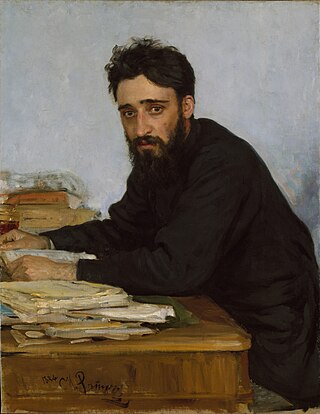Vsevolod Garshin
Russian author of short stories (1855–1888) From Wikipedia, the free encyclopedia
Vsevolod Mikhailovich Garshin (Russian: Всеволод Михайлович Гаршин; 14 February 1855 – 5 April 1888) was a Russian author of short stories.
You can help expand this article with text translated from the corresponding article in Russian. (July 2018) Click [show] for important translation instructions.
|
This article includes a list of general references, but it lacks sufficient corresponding inline citations. (June 2015) |
Vsevolod Garshin | |
|---|---|
 Portrait of Vsevolod Garshin by Ilya Repin | |
| Born | Vsevolod Mikhailovich Garshin February 14, 1855 Bakhmut uezd, Yekaterinoslav Governorate, Russian Empire |
| Died | April 5, 1888 (aged 33) Saint Petersburg, Russian Empire |
| Relatives | Yevgeny Garshin |
| Military career | |
| Service | Imperial Russian Army |
| Battles / wars | Russo-Turkish War |
Life
Summarize
Perspective
Garshin was the son of an officer, from a family tracing its roots back to a 15th-century prince, who entered into the service of Ivan the Great.[1] He attended secondary school and then the Saint Petersburg Mining Institute. He volunteered to serve in the army at the start of the Russo-Turkish War in 1877. He participated in the Balkans Campaign as a private, and was wounded in action. He was promoted to the rank of officer at the end of the war. He resigned his commission soon after in order to devote his time to literary efforts. He had previously published a number of articles in newspapers, mostly reviews of art exhibitions.[2]
His experiences as a soldier provide the basis for his first stories, including the very first, "Four Days" (Russian: "Четыре дня"), based on a real incident. The narrative is organized as the interior monologue of a wounded soldier left for dead on the battlefield for four days, face to face with the corpse of a Turkish soldier he had killed. Garshin's empathy for all beings is already evident in this first story.[citation needed]
Despite early literary success, he had periodical bouts of mental illness. Garshin attempted to commit suicide by throwing himself down the stone stairs leading to his apartment building. Although not immediately fatal, he died as a result of his injuries in a hospital in April 1888, at the age of 33.[3][4]
Work
Summarize
Perspective
The essence of Garshin's personality is a "genius" for pity and compassion, as intense as Dostoevsky's but free from all the "Nietzschean", "underground", and "Karamazov" ingredients of the greater writer.
Garshin's work is not voluminous: it consists of some twenty stories, all of them included in a single volume. His stories are characterized by a spirit of compassion and pity that some have compared to Dostoevsky's.[6]
In "A Very Short Novel" he examines the infidelity of a woman to a crippled hero. The story displays Garshin's talent for concentration and lyrical irony. "That Which Was Not" and "Attalea Princeps" are fables with animals and plants in human situations. The second of these stories has a sense of tragic irony.[7] In "Officer and Soldier-Servant" he is a forerunner of Chekhov; it is an excellently constructed story conveying an atmosphere of drab gloom and meaningless boredom. "From the Reminiscences of Private Ivanov" — the title story in the most recent English language collection of Garshin's work — has the same Russo-Turkish War setting of "Four Days", and includes as minor players the characters from "Officer and Soldier-Servant".[citation needed]
His best-known and most characteristic story is "A Red Flower"; it fits in the series of lunatic-asylum stories in Russian literature[7] (including Gogol's "Diary of a Madman" (1835), Leskov's The Rabbit Warren (1894) and Chekhov's "Ward No. 6" (1892)).[citation needed] "A Red Flower" translated as "The Scarlet Blossom" by Virginia Mary Crawford appeared in the London journal Time in Aug 1890.[8]
In 1883, Garshin was the model for the younger Ivan in Ilya Repin's painting Ivan the Terrible and His Son Ivan.[9]
Gallery
- Garshin in 1877, during his service in the Russo-Turkish War
- Vsevolod M. Garshin. Portrait by Ilya Repin (1883)
- Garshin as Ivan the Terrible's son
- Garshin in 1885
- 1885 cover of The Red Flower: A Literary Collection by Ilya Repin
- Garshin at his funeral in 1888
- Garshin's grave in Saint Petersburg
- 1955 stamp
References
External links
Wikiwand - on
Seamless Wikipedia browsing. On steroids.








